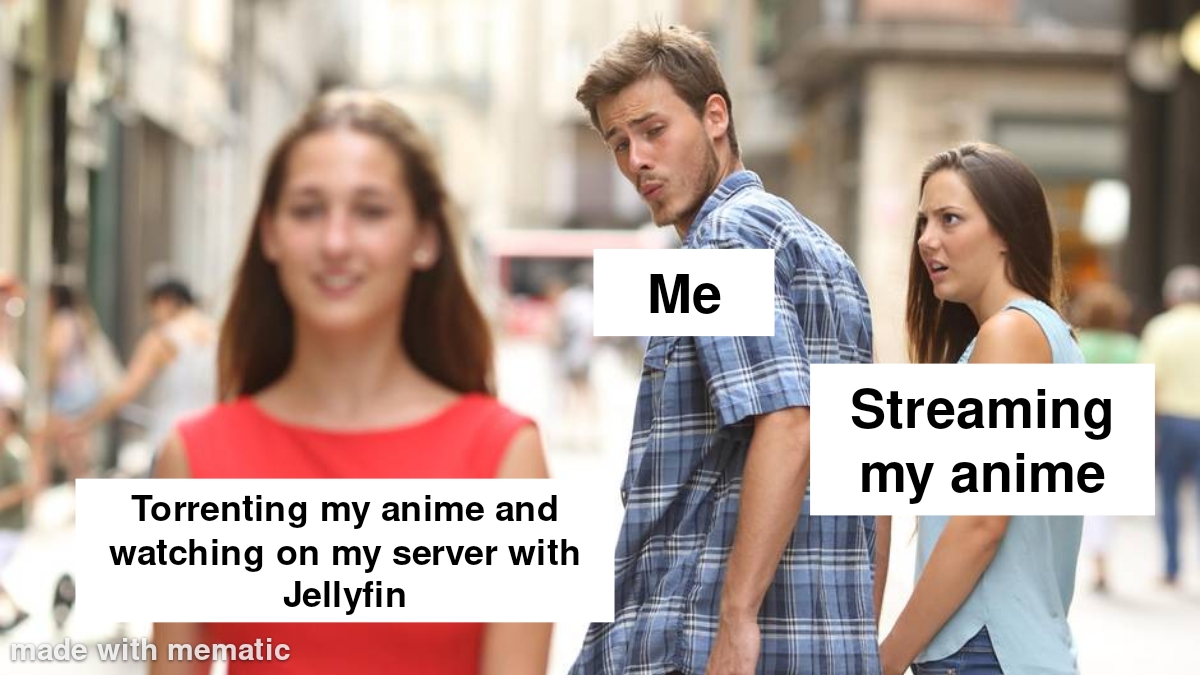this post was submitted on 28 Jan 2024
891 points (96.0% liked)
Piracy: ꜱᴀɪʟ ᴛʜᴇ ʜɪɢʜ ꜱᴇᴀꜱ
53843 readers
574 users here now
⚓ Dedicated to the discussion of digital piracy, including ethical problems and legal advancements.
Rules • Full Version
1. Posts must be related to the discussion of digital piracy
2. Don't request invites, trade, sell, or self-promote
3. Don't request or link to specific pirated titles, including DMs
4. Don't submit low-quality posts, be entitled, or harass others
Loot, Pillage, & Plunder
💰 Please help cover server costs.
founded 1 year ago
MODERATORS
you are viewing a single comment's thread
view the rest of the comments
view the rest of the comments




And it's easy to share your server with friends and relatives so that they don't have to go through the same process to watch these shows.
I was sharing my Netflix account with my mom and dad, now that I can't without paying more, I just pulled the plug on that subscription and add the shows they want to my server.
What is the easy way to share jellyfin over the internet? Portforwarding doesn't work for me cause I don't have a static ip address
EDIT: I thank all the answers but none of them seem actually easy
The issue of dynamic IP addresses is solved using a service like DuckDNS. Space Invader has some tutorials on it: https://youtu.be/CS72kN2c6hU
There is also ddns-updater which I like to use in docker
Run Opnsense or pfSense and do that from your firewall.
Here is an alternative Piped link(s):
https://piped.video/CS72kN2c6hU
Piped is a privacy-respecting open-source alternative frontend to YouTube.
I'm open-source; check me out at GitHub.
I just use a free dynamic DNS provider (ie: DuckDNS), and most home routers are able to publish IP address changes to that DNS, otherwise you just need a small software to publish those change, which you can do ok the server hosting Jellyfin.
Someone already suggested that but it seems to be missing a step, still need something to direct to the port I have for jellyfin?
That's just on your router, no?
no idea, I dont know how to do any of that
This tutorial explains everything in detail.
Edit: I stupidly assumed you are using windows. But anywayys...if you are thats a good tut
Here is an alternative Piped link(s):
This tutorial explains everything in detail.
Piped is a privacy-respecting open-source alternative frontend to YouTube.
I'm open-source; check me out at GitHub.
I am on windows, your stupidity paid off. Hooray stupid but lucky people! (sadly Im only stupid, not lucky)
Followed that guide and only managed to make my duckdns domain lead to my router...
You'll also need to do some port forwarding at the home router level so that external users can reach the server.
You'll preferably want to do what's called a DHCP reservation so that your server's internal IP address remains the same, then do a port forward from
your public port 8096tointernalIP:8096. That way, you just have to point someone outside of your network tohostname.duckdns.org:8096(which will get resolved to your current public IP address) for your Jellyfin server.tried doing hostname.duckdns.org:8096 and it didnt work so Im not sure its supposed to be like that, website mentions something called caddy
you'll need to have your own hostname and make it point to your home IP address, just in case it wasn't clear enough
It's good you are trying to help but I'm not sure someone copying and pasting whatever they read should have a port exposed to the Internet.
Purchase a domain and host it with a reverse proxy to your internal net.
You don't even need to purchase a domain, free dynDNS services (DuckDNS or similar) are good enough for Jellyfin and the like.
Free services always have some kind of dubious hidden product they are selling elsewhere about you to someone else, because network hardware is not free, network system maintenance is not free, internet access is not free. Facebook is free, yet we all know what it's true cost is.
DuckDNS is run by two guys who are funded by donations. I do agree with what you're saying about free services but I'm more willing to trust DuckDNS in this case
The easiest way is to setup tailscale on the server, then share the server with the web interface. Your friends/family simply install the tailscale client, login, and it just connects like magic. No port forwarding or firewall configuration required. There's plenty of how-tos out there.
tailscale.com
There's no way that's the simplest solution
Not the simplest to set up, to make accessible, to secure, or for everyone else to use? This solution is a pretty reasonable one considering all four.
You don’t need to do anything for plex
It just streams it straight to their brains?
JFL at using Plex with their shenanigans recently
VPN. Wireguard is pretty easy.
I wouldn't bother with a paid dynamic DNS. Most domain registrars let you change your DNS record with an API call (I know GoDaddy does because I use them.)
Then you just set up a cron job to fetch your IP and then change your DNS record to match. I use a subdomain because my main domain hosts a blog and some other stuff on a VPS, while my jellyfin server is at home.
A good search would be "[registrar name] dynamic DNS script"
How frequently does your cronjob run?
I think every 12 hours? I'm not sure. But it doesn't need to be super frequent, unless your IP changes often
Ddns is your answer, check your router and see what it can support or just go with whatever you feel good for you and install their updater on your server.
Run a VPS as a VPN server with ports forwarded. Run a VPN client on your router to forward Internet facing traffic from Jellyfin to said VPN tunnel. Essentially, open ports on the VPS instead of your own router. This is conceptually similar to Cloudflare tunnels.
I've set up a cloudflare tunnel, all you need is a domain. It forwards my local Jellyfin instance to the public web, and is easy to get started with. I'm not sure how secure it is though, so I would appreciate any advice from more enlightened pirates.
Doesnt matter if you have dynamic or static.
But it will matter once CG-NAT comes into play.
Sincerely a dynamic IP jellyfin user with a reverse proxy.
Is there an easy, free method of doing this securely and privately (as in masked from the ISP) in a way that doesn't involve me having to manage the network of the person I'm sharing with?
For example, I can use Tailscale for free, but then I have to make sure my friends know how to use that, and that's a tall order. Not to mention the fact it won't work on things like Roku.
VPN and have them punch in to a cheap or free cloud instance that acts as a hub router.
You give them a config file and they feed it to their device or router, use a private subnet in the 10.0.0.0/8 range because everyone is on 192.168.1.0/24 and then they just hit it at 10.0.0.1 or whatever.
I like Wireguard but you might have to use something with layer 2 support if you want service discovery to work for true zero config.
All good stuff, but I should clarify, the friends and family in question are not tech literate people. They call the internet "the wifi", get the shitty gateway from Spectrum and plug it in.
Assuming I can apply any sort of configuration to that device in the first place, the second something breaks, either I'm getting a call, or they'll call Spectrum and their rep will reset the gateway to defaults.
I'd also be hesitant to employ a VPN to cloud solution, because I have no idea what that's going to do to the speed.
Basically I was just asking if there was a free method of doing this securely and discreetly where the only thing they ever have to do is put an IP address into Jellyfin. I'm perfectly aware there may not be, I was just curious if there was a method I hadn't heard of.
Something I've kind of thought about is maybe, at least for my parents and closest friend, buying a cheap local machine (or repurposing an old OptiPlex or something) for them to keep in the house that I would mirror my library to, or least be able to manage remotely. "Sure, mom, you wanna see this? I'll tell your box to fetch it."
You have to expose it to the internet if you don't want your users to have to configure a vpn. Ensure good passwords and consider running a rate limiter.
Too keep hidden from ISP, you can use tailscale funnel.
Ok cool, didn't realize they'd added this.
If they can find a solution for Android not being able to run Tailscale and a different VPN at the same time, I'd finally be able to commit to it fully.
It isn't free, but I use a seedbox for running my Plex server. That way none of the media downloading is done on our local internet, all the ISP should see is that we are streaming data from a Plex server. They'd have no knowledge on if we own that data or not. I'm sure Jellyfin can also easily be run from a seedbox
Having a seedbox is also helpful because our internet has a pretty low upload speed, which would make watching anything outside the house a massive pain.